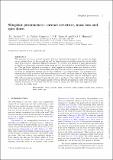Files in this item
Slingshot prominences : coronal structure, mass-loss and spin-down
Item metadata
| dc.contributor.author | Jardine, M. | |
| dc.contributor.author | Cameron, A. Collier | |
| dc.contributor.author | Donati, J. -F. | |
| dc.contributor.author | Hussain, G A J | |
| dc.date.accessioned | 2019-12-16T11:30:04Z | |
| dc.date.available | 2019-12-16T11:30:04Z | |
| dc.date.issued | 2020-01 | |
| dc.identifier | 264469366 | |
| dc.identifier | 0d0eb2e5-9598-4da3-893c-7e4604706b7e | |
| dc.identifier | 000512306500073 | |
| dc.identifier | 85104380354 | |
| dc.identifier.citation | Jardine , M , Cameron , A C , Donati , J -F & Hussain , G A J 2020 , ' Slingshot prominences : coronal structure, mass-loss and spin-down ' , Monthly Notices of the Royal Astronomical Society , vol. 491 , no. 3 , stz3173 , pp. 4076-4088 . https://doi.org/10.1093/mnras/stz3173 | en |
| dc.identifier.issn | 0035-8711 | |
| dc.identifier.other | crossref: 10.1093/mnras/stz3173 | |
| dc.identifier.other | ORCID: /0000-0002-8863-7828/work/66398287 | |
| dc.identifier.other | ORCID: /0000-0002-1466-5236/work/66398346 | |
| dc.identifier.uri | https://hdl.handle.net/10023/19134 | |
| dc.description | MJ and ACC acknowledge support from STFC consolidated grant number ST/R000824/1. JFD acknowledges funding from the European Research Council (ERC) under the H2020 research and innovation programme (grant agreement 740651 NewWorlds). | en |
| dc.description.abstract | The structure of a star’s coronal magnetic field is a fundamental property that governs the high-energy emission from the hot coronal gas and the loss of mass and angular momentum in the stellar wind. It is, however, extremely difficult to measure. We report a new method to trace this structure in rapidly-rotating young convective stars, using the cool gas trapped on coronal field lines as markers. This gas forms “slingshot prominences” which appear as transient absorption features in H-α. By using different methods of extrapolating this field from the surface measurements, we determine locations for prominence support and produce synthetic H-α stacked spectra. The absorption features produced with a potential field extrapolation match well this those observed, while those from a non-potential field do not. In systems where the rotation and magnetic axes are well aligned, up to 50% of the prominence mass may transit the star and so produces a observable feature. This fraction may fall as low as 2% in very highly inclined systems. Ejected prominences carry away mass and angular momentum at rates that vary by two orders of magnitude, but which may approach those carried by the stellar wind. | |
| dc.format.extent | 5853695 | |
| dc.language.iso | eng | |
| dc.relation.ispartof | Monthly Notices of the Royal Astronomical Society | en |
| dc.subject | Stars: coronae | en |
| dc.subject | Stars: late-types | en |
| dc.subject | Stars: magnetic fields | en |
| dc.subject | Stars: rotation | en |
| dc.subject | Stars: solar-type | en |
| dc.subject | QB Astronomy | en |
| dc.subject | DAS | en |
| dc.subject.lcc | QB | en |
| dc.title | Slingshot prominences : coronal structure, mass-loss and spin-down | en |
| dc.type | Journal article | en |
| dc.contributor.sponsor | Science & Technology Facilities Council | en |
| dc.contributor.institution | University of St Andrews. School of Physics and Astronomy | en |
| dc.contributor.institution | University of St Andrews. St Andrews Centre for Exoplanet Science | en |
| dc.identifier.doi | 10.1093/mnras/stz3173 | |
| dc.description.status | Peer reviewed | en |
| dc.identifier.grantnumber | ST/R00824/1 | en |
This item appears in the following Collection(s)
Items in the St Andrews Research Repository are protected by copyright, with all rights reserved, unless otherwise indicated.

